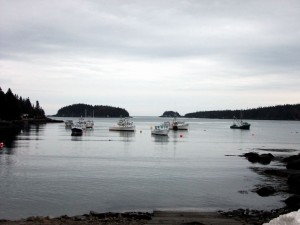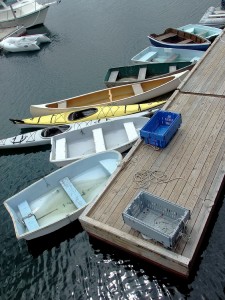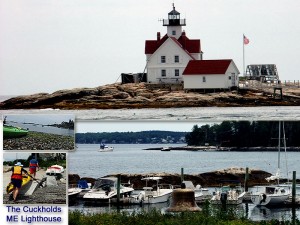Sailing a boat in Maine capturing the prevailing winds using one or a series of multi shaped and sized sails.
It’s one more method to travel using the waterways of Vacationland. But when someone mentions Maine, sailing. Just two words. What pops into your gray matter behind your eyes, between your ears? Expensive? Elite? A US President or a movie star with huge yachts no one uses but parked like landscape candy ready ad waiting in front of palatial Maine oceanfront estates?
Or no thank you. Just no interest in hoisting the canvas sail, messing with learning rope knots and lowering the keel centerboard. Because your version of boating is the 14 foot aluminum craft kind. With a can of worms, a thermos of hot coffee or cooler of cold barley pop. The electric trolling motor hung off the back doing its back and forth plying the water. Parked next to the 8 horsepower Mercury or Johnson boat motor that pushes you around inland fresh water lakes with more determination. Maybe out into salt water bays and inlets for deep sea fishing for something beyond brook trout and land locked salmon or bass fish. The boat and assorted hardware and safety gear application designed for Maine fishing. Or larger powered boats or personal watercraft jet skis for tubing, for water skiing round and round a Maine lake.

But sailing in Maine.
SSssshhhhhh. Listen. Hear that? It’s quiet and you can hear yourself think. Back to the blog post topic and staying on task with today’s hunt and peck exercise. That often is to learn along with the reader about a subject that I am not so knowledgeable about from first hand experiences. Exploring the fun in sailing a sloop with whatever size beam or required amount of water draft. Climb aboard and help me figure out what a roller furling is on the oversized dodger.
Growing up I had a friend Mark McNutt who’s Dad loved boats of all kinds. Tri hull fiberglass pontoon boats that were faster than the typical aluminum ones. Rubber rafts with motors. Paddle boats modified with roof awnings and a four horsepower motor. And O’Day sailing boats. (Just read in researching this Maine blog posts O’Day Boats went out of business in 1989). All used on a Maine lake, not the ocean playground marine setting. The sail boater taught the basics of how to harness the wind in a small waterfront contained setting.
In Uncle Henry’s buy sell swap guide you see lots of small day sailing boats… like a laser or Hobie Cat sail boat. Simple, basic but the way to start out to see if sailing a boat is for you.
Laser sunfish sail boats are the simple one or two person entry level boats to hoist the sail and begin the addiction.
You can buy these small sail boats for little money and kids have fun learning the joy of tapping the breeze to propel the boat. I have seen them offered for free or for a token $400 and that includes the boat, the gear, the trailer to haul it home to your place. But would you use it or dump it in ten years from being tired of looking at it in your space like the last sail boat owner?

How to get proficient at jibing and tacking are two basics tasks with say your Hobie cat sailboat to master first when you are a beginner sailor. But if you are doing it with other crew mates especially, the boat locations have to be learned. Port side is the left. Starboard is on the right. The front of the boat is the bow. The rear end is the aft. You learn that quickly on a cruise ship to get around and have your sea leg bearings.
Everyone has to be using the same sail boating terminology to avoid confusion.
Learning the parts of the boat locations makes the instructions on sailing easier to follow. Plus you get a taste of sea life, being the boat captain and a bit of pirate all rolled up into one experience as a land lubber matey.
Nautical terms of sailing, what else comes with the instructions on how to open up or use your sailboat in Maine.
Hopefully, you skipper and all the crew won’t have to use the one about abandon ship. Not sure if there is a plank to walk if the crew does decide to mutiny either. What are the keel, ketch, sloop, cutter and yawl? Parts of the sailboat vessel.
Had a real estate farm for sale owner who bought a yawl that was not in the best of shape but that the couple restored. Making their own hand sewn sails, refinishing the mahogany, updating electrical and restoring the mechanical systems to make it ship shape. Using the yatch to sail back and forth to Halifax Nova Scotia. And taking turns for the night watch. One night the boat almost hitting a floating dead whale. The name of the over 40 long yawl boat was Heart Strings. Because the owner’s sweat, tears, love for it tugged on their heart strings. They sold it to a man who knew nothing about boating but who had a fat wallet. He changed the name on the aft to “Mustang”.

Another couple that bought a property lived on a boat full time for a couple years. It is interesting hearing about adventures many of the real estate buyers and sellers share. The boyfriend pretty mechanically inclined and buying a sail boat / house boat with a very systematic approach. They drew a circle of so many miles around their home in Boston Massachusetts. And began the search for boatyard marinas in that circle.
The mission to locate a sailboat yacht in storage for many years.
With the bill for the storage high enough for the boatyard to want to get rid of it. Or the owners of the boat suddenly elderly or widowed and wanting to dump it for little cash. Because their stash of cash was a small one requiring major league stretching to make this living on a boat dream a reality.
Beginners luck. They found the sailboat the very first call, the beginning of “let your fingers do the walking” through the boat yard search list.
They moved around like floating gypsies on their sailboat house boat.
Taking the required coast guard courses to comply with the rules of the nautical highway life on the high seas. The rules are so so different for boats under 26 feet in length. What licenses, regulations for recreational sailing are required? Well, first and foremost, navigation, nautical charts is pretty important before you raise anchor and remove the dock mooring ropes.
I remember being on a blue fish trip off South Harpswell ME and suddenly a fog wrapped around the boat like pea soup. Our skipper grew up in Ellsworth ME and had lots of experience with the ocean. Something living in Aroostook County does not prepare you for so he calmly dug out the nautical map sealed in plastic laminate. And from our current location using the compass predicted we would be hearing and then seeing a green floating buoy off the starboard side of our modest fishing boat. We did, and then glancing at the chart as he steered the outboard motor from the back corner of the boat reported we should be seeing a red buoy on the port side…. which we heard first and then watched it appear in from out of the blanket of mist.

Our crew arrived back on the shores of Catalina Island and enjoyed a feast of fresh dug mussels steamed, dipped in Houlton Farms Dairy melted butter that was to die for delicious. Catalina Island has lots of World War Two abandoned bunker armaments that were cool to explore. Hurricane Hugo happened during our weekend camping trip to fish for the blues and in a tent, it was an adventure to remember.
Anytime I see a sailboat for sale in my travels or on craigslist or Uncle Henry’s it is dirt cheap.
Probably because the owner had their fun, it is one of many boats hanging around their property unused and neglected. Just get it off my lawn and out of my barn or garage low priced. No motor helps keep the sticker price for the third and fourth time around sail boat affordable too. If you visit Kennebunkport or the Beaches Region of Maine, like say in Wells or Moody Beach that all changes. Along with the higher priced waterfront properties, the cost of the floating toys increases in value and swankiness. Many lakes, ocean front groups have regattas and take their sailing boat races very seriously.
I’m Maine REALTOR Andrew Mooers, ME Broker
207.532.6573 | info@mooersrealty.com |
MOOERS REALTY 69 North Street Houlton Maine 04730 USA
